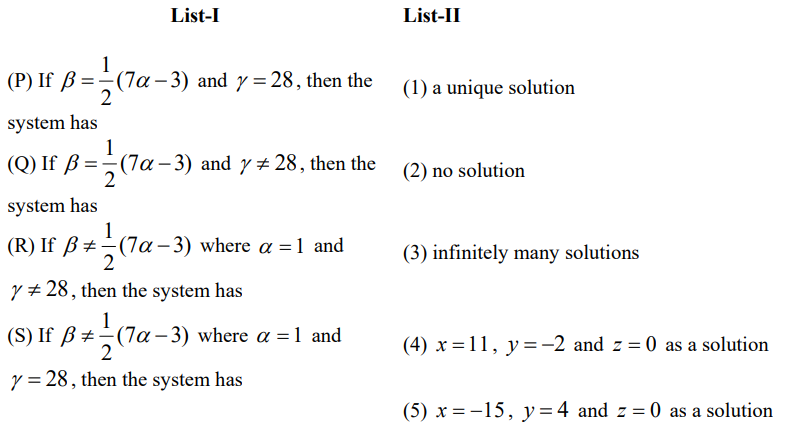Let α,βandγ be real numbers such that the system of linear equations
x+2y+3z=α
4x+5y+6z=β
7x+8y+9z=γ−1
Let P be the plane containing all those (α,β,γ) for which the above system of linear equations is consistent, and D be the square of the distance of the point (0,1,0) from the plane P.
The value of D is ______
To solve the problem, we need to determine the conditions under which the given system of linear equations is consistent, and then calculate the square of the distance from the point (0, 1, 0) to the corresponding plane.
Step 1: Set up the system of equations
The system of equations is given as:
1. x+2y+3z=α
2. 4x+5y+6z=β
3. 7x+8y+9z=γ−1
Step 2: Formulate the augmented matrix
We can write the augmented matrix for the system as follows:
⎡⎢⎣123|α456|β789|γ−1⎤⎥⎦
Step 3: Find the determinant of the coefficient matrix
The coefficient matrix is:
⎡⎢⎣123456789⎤⎥⎦
We calculate the determinant of this matrix:
det=1⋅(5⋅9−6⋅8)−2⋅(4⋅9−6⋅7)+3⋅(4⋅8−5⋅7)
Calculating each term:
- 5⋅9−6⋅8=45−48=−3
- 4⋅9−6⋅7=36−42=−6
- 4⋅8−5⋅7=32−35=−3
Thus,
det=1⋅(−3)−2⋅(−6)+3⋅(−3)=−3+12−9=0
Step 4: Condition for consistency
Since the determinant is 0, the system of equations is consistent if the corresponding augmented matrix does not lead to a contradiction. This means that the values of α,β, and γ must satisfy a certain linear relationship.
Step 5: Find the relationship between α,β,γ
From the previous analysis, we can derive that for the system to be consistent:
2β=α+γ−1
Rearranging gives:
α+γ−2β+1=0
Step 6: Identify the plane P
This equation represents a plane in the (α,β,γ) space. We can express it in the standard form:
α+γ−2β=−1
Step 7: Calculate the distance from the point (0, 1, 0) to the plane
The point we are interested in is (0,1,0) which corresponds to α=0,β=1,γ=0.
Substituting into the plane equation:
0+0−2(1)=−2(which does not equal -1)
To find the distance from the point to the plane, we use the formula for the distance d from a point (x0,y0,z0) to the plane Ax+By+Cz+D=0:
d=|Ax0+By0+Cz0+D|√A2+B2+C2
Here, A=1,B=−2,C=1,D=1 (from rearranging the plane equation).
Calculating the distance:
d=|1⋅0−2⋅1+1⋅0+1|√12+(−2)2+12=|0−2+0+1|√1+4+1=|−1|√6=1√6
Step 8: Calculate D
Since D is the square of the distance:
D=(1√6)2=16
Thus, the final answer is:
16
The system of equations is given as:
1. x+2y+3z=α
2. 4x+5y+6z=β
3. 7x+8y+9z=γ−1
We can write the augmented matrix for the system as follows:
⎡⎢⎣123|α456|β789|γ−1⎤⎥⎦
The coefficient matrix is:
⎡⎢⎣123456789⎤⎥⎦
We calculate the determinant of this matrix:
det=1⋅(5⋅9−6⋅8)−2⋅(4⋅9−6⋅7)+3⋅(4⋅8−5⋅7)
Calculating each term:
- 5⋅9−6⋅8=45−48=−3
- 4⋅9−6⋅7=36−42=−6
- 4⋅8−5⋅7=32−35=−3
det=1⋅(−3)−2⋅(−6)+3⋅(−3)=−3+12−9=0
Since the determinant is 0, the system of equations is consistent if the corresponding augmented matrix does not lead to a contradiction. This means that the values of α,β, and γ must satisfy a certain linear relationship.
From the previous analysis, we can derive that for the system to be consistent:
2β=α+γ−1
Rearranging gives:
α+γ−2β+1=0
This equation represents a plane in the (α,β,γ) space. We can express it in the standard form:
α+γ−2β=−1
The point we are interested in is (0,1,0) which corresponds to α=0,β=1,γ=0.
0+0−2(1)=−2(which does not equal -1)
d=|Ax0+By0+Cz0+D|√A2+B2+C2
Here, A=1,B=−2,C=1,D=1 (from rearranging the plane equation).
d=|1⋅0−2⋅1+1⋅0+1|√12+(−2)2+12=|0−2+0+1|√1+4+1=|−1|√6=1√6
Since D is the square of the distance:
D=(1√6)2=16
16
Topper's Solved these Questions
Similar Questions
Let α,βandγ be real numbers such that the system of linear equations
x+2y+3z=α
4x+5y+6z=β
7x+8y+9z=γ−1
Let P be the plane containing all those (α,β,γ) for which the above system of linear equations is consistent, and D be the square of the distance of the point (0,1,0) from the plane P.
The value of |M| is ______
View SolutionLet α,βandγ be real numbers. Consider the following system of linear equations
x+2y+z=7
x+αz=11
2x−3y+βz=γ
Match each entry in List-I to the correct entries in List-II.

The correct option is:
View Solution
Knowledge Check
Consider the system of equations :
x + y + z = 0
αx+βy+γz=0
α2x+β2y+γ2z=0
then the system of equations hasAa unique solution for all values of α,β,γBinfinite number of solutions if any two of α,β,γ are equalCa unique solution if α,β,γ are distinctDmore than one,but finite number of solutions depending on values of α,β,γIf the system of linear equations :
x+4y-3z=2
2x+7y+4z=α
-x-5y+5z=β
has infinitely many solutoins than the ordered pair (α,β) cannot take value :A(4,-2)B(2,-4)C(3,-3)D(-3,3)An ordered pair (α,β) for which the system of linear equations
(1+α)xβy+z=2
αx+(1+β)y+z=3
αx+βy+2z=2
has a unique solution, isA(2, 4)B(−4,2)C(1,−3)D(−3,1)
If x =α,y=β,z=γ is a solution of the system of equations
x+y+z=4
2x-y+3z=9
View SolutionIf α+β+γ=2π, then the system of equations
x+(cosγ)y+(cosβ)z=0
(cosγ)x+y+(cosα)z=0
(cosβ)x+(cosα)y+z=0
has :
View SolutionFor real numbers αandβ, consider the following system of linear equations: x+y−z=2,x+2y+αz=1,2x−y+z=β. If the system has infinite solutions, then α+β is equal to ____
View SolutionIf α,β,γ are the cube roots of p,p<0 then for any x, y and z
xα+yβ+zγxβ+yγ+zα =
View SolutionIf the system of linear equations
x+4y−3z=2
2x+7y−4z=α
−x−5y+5z=β
has infinitely many solutions then the ordered pair (α,β) cannot take value
View Solution
